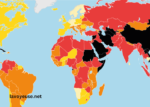In the world of journalism and media, understanding how different news outlets rank is essential for both consumers and professionals. The Classement DE LA Presse plays a crucial role in providing this insight by ranking newspapers, magazines, and digital platforms based on various criteria, including circulation, audience engagement, and editorial quality. This ranking system helps audiences make informed decisions about the sources they trust for news and information.
With the rise of digital platforms and online media, the way in which we consume news has dramatically shifted. As such, traditional rankings of newspapers and magazines have evolved, and the Classement DE LA Presse offers an up-to-date perspective on the performance of these outlets. Understanding how media organizations perform in this ranking is crucial not only for media professionals but also for advertisers, marketers, and the general public who depend on the credibility and reach of the press for accurate reporting.
What Is the Classement DE LA Presse?
The Classement DE LA Presse is a ranking system used to evaluate and categorize media outlets based on specific metrics that measure their influence, reach, and impact. This ranking is crucial for understanding which outlets are leading the media landscape, particularly in countries where press freedom and journalistic integrity are central to democracy. The Classement DE LA Presse provides a clear picture of which publications are most trusted and widely consumed by the public.
It takes into account various factors, such as circulation figures, online readership, social media presence, and editorial content quality. These rankings help journalists, advertisers, and the public assess which news sources are the most credible and influential. The Classement DE LA Presse has become a benchmark in evaluating media performance, offering transparency into the industry’s state and trends.
By relying on measurable data, the Classement DE LA Presse removes much of the subjectivity from ranking media outlets, making it a trusted tool for media analysis. It not only provides a numerical ranking but also offers insight into the changing trends within the media landscape, helping readers stay informed about which sources are shaping public discourse.
How Is the Classement DE LA Presse Determined?
The Classement DE LA Presse is determined through a variety of methods that aggregate data from different sources. The most important factor considered is the circulation of print media, which reflects the reach of newspapers and magazines. Circulation is typically measured through subscription numbers, individual sales, and distribution data. For digital outlets, online readership is a key component, including website traffic, the number of active users, and the amount of content consumed.
Another important element in the Classement DE LA Presse is social media engagement. The amount of interaction a media outlet receives on platforms like Facebook, Twitter, and Instagram reflects its popularity and influence in the digital space. The number of shares, likes, and comments on articles can indicate how widely a piece of content is being distributed and discussed, which is a strong indicator of its public resonance.
Editorial content quality is also factored into the Classement DE LA Presse. This includes not only the factual accuracy and thoroughness of reporting but also the overall credibility and ethical standards of the media organization. Outlets that adhere to journalistic best practices, fact-checking, and ethical journalism principles are likely to score higher in the rankings. The combination of these factors provides a comprehensive evaluation of the media’s standing in the current media ecosystem.
Why Is the Classement DE LA Presse Important?
The Classement DE LA Presse serves multiple purposes, the most important of which is offering transparency about the state of the media industry. By ranking outlets based on measurable criteria, it helps the public understand which sources they should trust for accurate and up-to-date information. In an era of misinformation and fake news, the Classement DE LA Presse offers a way to distinguish reliable, well-established outlets from those that may lack editorial integrity.
For advertisers, the Classement DE LA Presse is invaluable in determining where to place their advertisements for maximum exposure. Higher-ranked outlets generally offer more visibility and reach, making them prime targets for marketing campaigns. Understanding the Classement DE LA Presse allows businesses to make informed decisions about where to allocate their advertising budget.
For media professionals, the Classement DE LA Presse provides insights into industry trends and the performance of competitors. Journalists, editors, and publishers use these rankings to assess the effectiveness of their own outlets and to adjust strategies accordingly. Media organizations that perform well in the Classement DE LA Presse may gain prestige and influence, leading to increased credibility and readership.
How Do Digital Media Outlets Perform in the Classement DE LA Presse?
With the rise of digital media, many traditional print outlets are struggling to keep up with the rapidly changing media landscape. The Classement DE LA Presse has evolved to reflect the growing importance of online media outlets, with digital-first publications like online news platforms, blogs, and social media influencers now competing with traditional newspapers and magazines for top rankings.
Digital media outlets perform differently in the Classement DE LA Presse compared to their print counterparts. While traditional outlets may still have an edge in terms of print circulation, digital outlets often have higher levels of engagement due to the nature of social media and online interactions. For example, a digital outlet that regularly goes viral on social media platforms may achieve higher rankings due to its widespread influence, even if its print circulation is minimal.
The Classement DE LA Presse recognizes these differences by considering online metrics like website traffic, user engagement, and social shares. The rankings reflect the growing dominance of digital content consumption and provide a more accurate picture of the media industry today. While traditional outlets are still prominent, digital-first media is becoming increasingly influential, and the Classement DE LA Presse helps track this shift.
How Does the Classement DE LA Presse Impact Media Consumption?
The Classement DE LA Presse plays a critical role in influencing how the public consumes news. When media outlets are ranked highly in this classification, it often leads to increased readership and trust. Audiences tend to gravitate toward outlets that are considered credible, influential, and well-established, which is why the Classement DE LA Presse is so significant.
This ranking also influences how people interact with media outlets. Readers are more likely to share content from outlets that rank highly in the Classement DE LA Presse, increasing the visibility and reach of their stories. The credibility attached to high-ranking outlets often leads to more engagement, more loyal followers, and an overall increase in consumer trust.
For new readers or individuals looking to get informed, the Classement DE LA Presse serves as a guide to reputable sources of news. It helps audiences navigate the complex media landscape by identifying which outlets are trusted by the majority and are more likely to provide accurate, balanced, and in-depth reporting.
What Are the Benefits of Using the Classement DE LA Presse for Advertisers?
For advertisers, the Classement DE LA Presse provides a wealth of insights that can be leveraged to improve marketing strategies. By analyzing the top-ranked media outlets, advertisers can determine where their target audiences are most likely to be. Whether it’s a major national newspaper or a popular digital news platform, the Classement DE LA Presse helps advertisers focus their efforts on the most influential and widely consumed outlets.
Furthermore, the Classement DE LA Presse provides insight into audience demographics. Knowing which media outlets have the most engaged and relevant audience allows advertisers to create more targeted and effective campaigns. High-ranking outlets typically have established brands with loyal followers, which increases the likelihood that advertisements will be seen and acted upon.
Advertisers who are aware of the Classement DE LA Presse rankings can also identify emerging media outlets that are gaining traction. Investing in up-and-coming outlets that are climbing the ranks can be an effective strategy for reaching a new audience and positioning a brand in the right place at the right time.
Conclusion
The Classement DE LA Presse provides valuable insights into the media landscape, ranking news outlets based on their reach, credibility, and influence. Whether for consumers, advertisers, or media professionals, understanding these rankings is essential for making informed decisions about where to get news, where to advertise, or how to improve a media outlet’s standing.
The Classement DE LA Presse not only offers transparency into the current state of the press but also helps guide the public and professionals in navigating the ever-evolving media world. As the media continues to change, this ranking system will remain an indispensable tool for understanding the role of press outlets in shaping public discourse.

